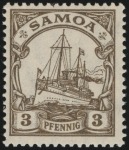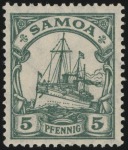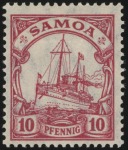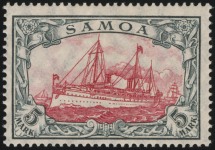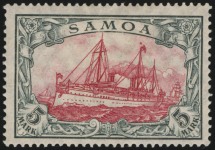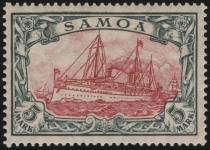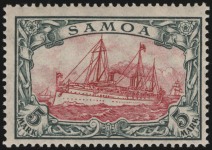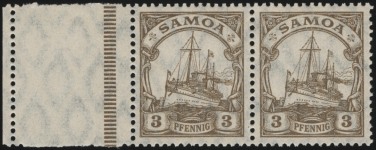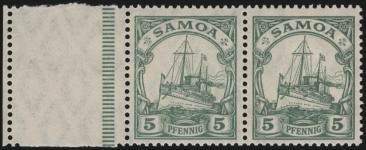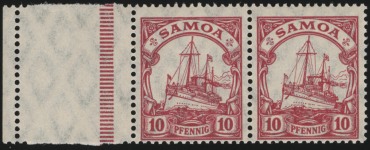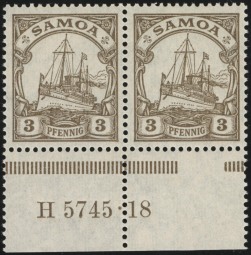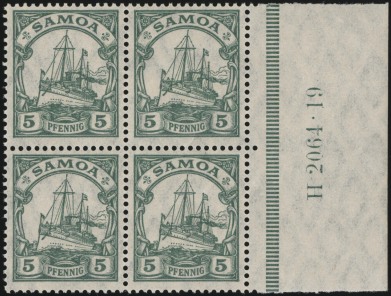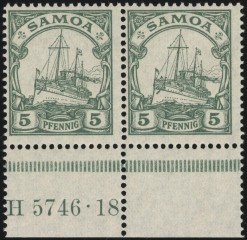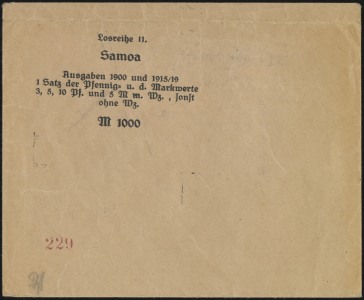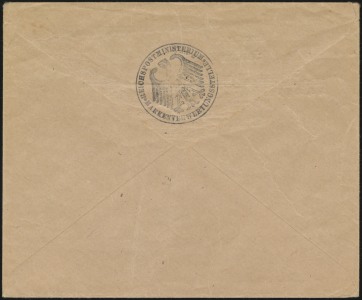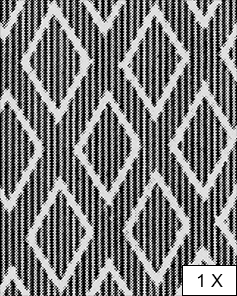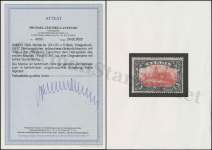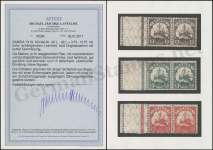1915 / 1919 Yacht Issues
Beginning in 1905, Germany began phasing in the use of watermarked paper on its new issues.
This practice eventually led to the introduction of new Yacht issues which were similar to the 1900/1901 issues, but featured a lozenge-shaped watermark.
The 1915/1919 Yacht Issues were never postally used due to the fall of the German Samoa. The stamps were only sold at philatelic sales windows in Berlin.
MiNr. 23 I A is a “peace printing” issued in Jan 1915, and therefore shows different qualities from the remaining “war printing” (Apr-May 1919) issues of this set. It is lighter in color overall, with better quality paper and printing.
MiNr. 23 can be found with a plate flaw.
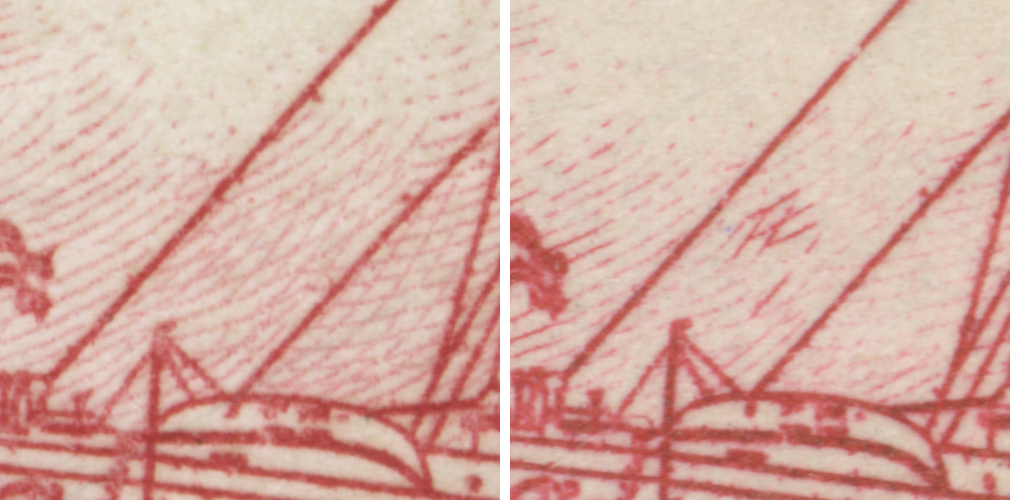
MiNr. 23 Plate Flaw I — retouching between rigging (right)
MiNr. 20-22 were printed in 10×10 sheets, which were then run through a perforation machine. The machine used to perforate an unknown number of these sheets was designed to perforate two 10×10 sheets printed side-by-side with a margin in-between, rather than a single 10×10 sheet as the stamps were printed. This resulted in an extra perforation along the left margin of the sheet. For this reason, left margin copies of some printings of these issues can be found with a perforated margin, giving the appearance of a blank field attached at the left. These copies command a significant premium.
In 1902, the Reichsdruckerei (Reich Printing Office) began printing in the margins of stamp sheets the internal order number under which the stamps were printed. This order number, or Hausauftragsnummer (HAN), varied in location, typically being found in the right or bottom margin.
Additionally, in 1923, the Reichspostministerium (German Postal Ministry) conducted a sale of old German postage to help fund German reparations payments to the Allies. Complete sets were sold in envelopes specifically printed for this purpose. The back has the seal of the Reichspostministerium Markenverwertungsstelle, the office of the German Postal Ministry responsible for stamp sales.
The larger format Yacht Issues of the German Colonies have slight differences in color, perforation, or frame/center types. For a detailed description of the frame/center types, see the guide to Colonial Frame & Center Types.
1915 / 1919 Yacht Issues
Beginning in 1905, Germany began phasing in the use of watermarked paper on its new issues.
This practice eventually led to the introduction of new Yacht issues which were similar to the 1900/1901 issues, but featured a lozenge-shaped watermark.
The 1915/1919 Yacht Issues were never postally used due to the fall of the German Samoa. The stamps were only sold at philatelic sales windows in Berlin.
MiNr. 23 I A is a “peace printing” issued in Jan 1915, and therefore shows different qualities from the remaining “war printing” (Apr-May 1919) issues of this set. It is lighter in color overall, with better quality paper and printing.
MiNr. 23 can be found with a plate flaw.

MiNr. 23 Plate Flaw I — retouching between rigging (right)
MiNr. 20-22 were printed in 10×10 sheets, which were then run through a perforation machine. The machine used to perforate an unknown number of these sheets was designed to perforate two 10×10 sheets printed side-by-side with a margin in-between, rather than a single 10×10 sheet as the stamps were printed. This resulted in an extra perforation along the left margin of the sheet. For this reason, left margin copies of some printings of these issues can be found with a perforated margin, giving the appearance of a blank field attached at the left. These copies command a significant premium.
In 1902, the Reichsdruckerei (Reich Printing Office) began printing in the margins of stamp sheets the internal order number under which the stamps were printed. This order number, or Hausauftragsnummer (HAN), varied in location, typically being found in the right or bottom margin.
Additionally, in 1923, the Reichspostministerium (German Postal Ministry) conducted a sale of old German postage to help fund German reparations payments to the Allies. Complete sets were sold in envelopes specifically printed for this purpose. The back has the seal of the Reichspostministerium Markenverwertungsstelle, the office of the German Postal Ministry responsible for stamp sales.
The larger format Yacht Issues of the German Colonies have slight differences in color, perforation, or frame/center types. For a detailed description of the frame/center types, see the guide to Colonial Frame & Center Types.

